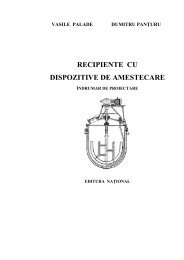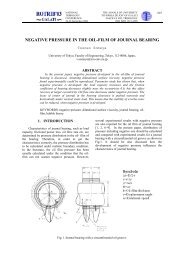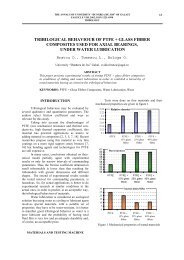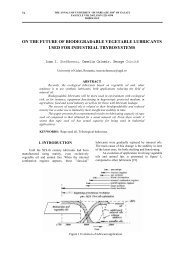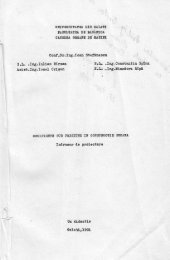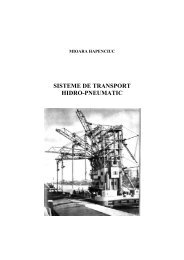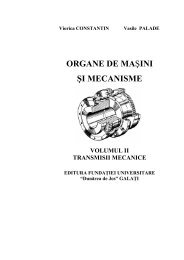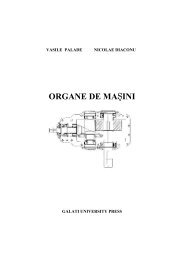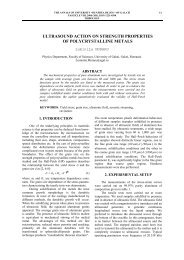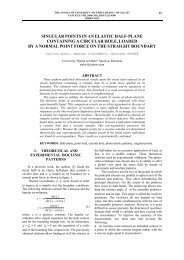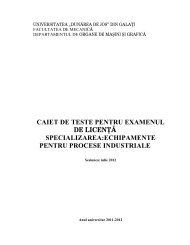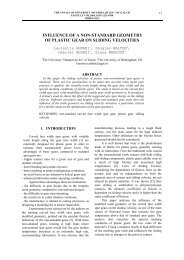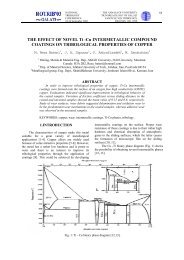flammability test data in risk assessment
flammability test data in risk assessment
flammability test data in risk assessment
You also want an ePaper? Increase the reach of your titles
YUMPU automatically turns print PDFs into web optimized ePapers that Google loves.
THE ANNALS OF UNIVERSITY “DUNĂREA DE JOS“ OF GALAŢI<br />
FASCICLE VIII, 2008 (XIV), ISSN 1221-4590<br />
TRIBOLOGY<br />
71<br />
Table 1. Fire <strong>test</strong>s for hydraulic fluids.<br />
Test Fluid state and ignition source / standards Measurements<br />
flash po<strong>in</strong>t<br />
Cleveland Open Cup Tester<br />
Temperature value for flash po<strong>in</strong>t<br />
[26, 36]<br />
ISO 2592:2001, ASTM D92-05a, BS 4689:1980, IP 36<br />
fire po<strong>in</strong>t<br />
Cleveland Open Cup Tester<br />
Temperature value for fire po<strong>in</strong>t<br />
[10, 26]<br />
ISO 2592:2001, ASTM D92-05a<br />
open flame ignition<br />
of a fluid spray<br />
[28, 31, 42]<br />
spark ignition of a<br />
fluid spray [42]<br />
hot surface ignition<br />
of a fluid spray<br />
[24, 29, 42]<br />
open flame ignition<br />
of bulk fluid [40]<br />
<strong>flammability</strong> on hot<br />
surfaces (plate or<br />
manifold) [19, 39]<br />
autoignition of fluid<br />
ignition of fluid<br />
soaked rags [2, 11]<br />
ignition of fluid on<br />
an absorbent<br />
medium [16]<br />
spray from 6.89MPa hollow cone nozzle – ISO 15029-1,<br />
7 th LR 3.1.2, FM 6930:2002, RP55H * , ASTM D5306-<br />
92(2002)e1<br />
open flames may range from that equivalent to a match to<br />
a blowtorch<br />
Sparks energy <strong>in</strong> the range of 2mJ…2J<br />
several types of sprays <strong>in</strong>clud<strong>in</strong>g that from ISO 15029-2,<br />
7 th LR 3.1.3, RP55H *<br />
flat hot plates with fixed temperatures up to 600°C, the<br />
hot surface is mov<strong>in</strong>g through the fluid spray, vary<strong>in</strong>g<br />
<strong>in</strong>cl<strong>in</strong>ation and surface temperature.<br />
a standard pool of fluid,<br />
a fluid stream on an <strong>in</strong>cl<strong>in</strong>ed plate, exposed to an open<br />
flame; a range of open flame ignition sources<br />
the fluid drops are fallen on a manifold heated<br />
up to 700°C, i.e.: ISO 20823:2003<br />
Federal Test Method 791, Method 6053.1.<br />
the determ<strong>in</strong>ation of hot- and cool-flame autoignition temperatures of a<br />
liquid chemical <strong>in</strong> air at atmospheric pressure <strong>in</strong> a uniformly heated<br />
vessel. i.e.: DIN 51794, ASTM E659-78(2005)<br />
fluid-soaked m<strong>in</strong>eral wool heated <strong>in</strong> an oven for an<br />
extended period of time at a fixed temperature.<br />
The <strong>test</strong> may provide pert<strong>in</strong>ent <strong>in</strong>formation for safe<br />
transportation and storage.<br />
ISO 14935:1998, 7 th LR 3.1.3, RP66H * .<br />
the heat release rate of the ignition<br />
source<br />
occurrence and position of any<br />
ignition<br />
l<strong>in</strong>ear flame propagation rate<br />
the occurrence, energy and position of<br />
any ignition with<strong>in</strong> the spray<br />
temperature of the hot plate measured<br />
usually by <strong>in</strong>frared unit<br />
ignition occurrence<br />
observations of any ignition, time to<br />
ignition and shape and position of the<br />
flame<br />
manifold temperature may be fixed up to 700°C<br />
any noticed ignition, persistence of burn, flash<br />
on, above or under the tube<br />
autoignition<br />
temperature **<br />
bulk temperature, exposure time and<br />
occurrence of any exothermal process are<br />
monitored<br />
<strong>assessment</strong> of the persistence of a flame<br />
applied to the edge of a wick of nonflammable<br />
material immersed <strong>in</strong> fireresistant<br />
fluid.<br />
7 th LR - 7 th Luxembourg Report<br />
* All CETOP Technical Recommendations are no longer available for purchase from June 2002 and are officially<br />
withdrawn but similar text might have been <strong>in</strong>cluded <strong>in</strong> other official documents.<br />
** This standard should be used to measure the properties of materials, products, or assemblies <strong>in</strong> response to heat and<br />
flame under controlled laboratory conditions and should not be used to describe or appraise the fire hazard or fire <strong>risk</strong> of<br />
these under actual fire conditions. However, results of this <strong>test</strong> may be used as elements of a fire <strong>risk</strong> <strong>assessment</strong> which takes<br />
<strong>in</strong>to account all of the factors which are pert<strong>in</strong>ent to an <strong>assessment</strong> of the fire hazard of a particular use.<br />
Table 2. Compar<strong>in</strong>g two <strong>test</strong><strong>in</strong>g methods for <strong>test</strong><strong>in</strong>g fluid <strong>flammability</strong> on hot surfaces.<br />
Manifold Ignition Test (Federal Test Method<br />
791, Method 6053.1) [40],<br />
EN ISO 20823:2003 Petroleum and related products -<br />
Determ<strong>in</strong>ation of the <strong>flammability</strong> characteristics of fluids <strong>in</strong><br />
contact with hot surfaces - Manifold ignition <strong>test</strong><br />
Test parameters<br />
simulated manifold is heated at 700°C, temperature measured <strong>in</strong><br />
three po<strong>in</strong>ts, fluid volume rate: 10 ml <strong>in</strong> 40...60 sec; fluid<br />
temperature 20...25°C, dispenser tip at 300mm above the probably<br />
impact po<strong>in</strong>t on the manifold,<br />
sheet metal box 300 x 300 x 450 (mm)<br />
Test evaluation<br />
I(T), when the fluid flashes or burns on the tube but does not<br />
cont<strong>in</strong>ue to burn when collected <strong>in</strong> the tray below,<br />
I(D), when the fluid flashes or burns on the tube and cont<strong>in</strong>ues to<br />
do so when collected <strong>in</strong> the tray below,<br />
N when the fluid does not flash or burn at any time.<br />
N when the fluid does not flash or bur nat any time.<br />
simulated manifold is heated at 704°C (1300°F),<br />
temperature measured at one po<strong>in</strong>t <strong>in</strong> the central<br />
zone of the manifold, fluid volume rate: 10 ml <strong>in</strong><br />
40...60s<br />
sheet metal box: 300 x 300 x 460 (mm)<br />
a. flashes and burns on the manifold but not after<br />
dripp<strong>in</strong>g from the manifold,<br />
b. does not flash or burn on the manifold but does<br />
after dripp<strong>in</strong>g from the manifold,<br />
c. the fluid does not flash or burn on manifold or<br />
after dripp<strong>in</strong>g from the manifold.<br />
contacts a hot metallic surface hav<strong>in</strong>g at fixed<br />
temperature. The method also allows establish<strong>in</strong>g the<br />
ignition temperature of the studied fluid by vary<strong>in</strong>g<br />
the manifold temperature.<br />
The standard ISO 20823 was the subject of a<br />
debate <strong>in</strong> the ISO/TC 28 [44]. The method appears<br />
simply but it has not to be vague, so many comments<br />
were done on express<strong>in</strong>g the pr<strong>in</strong>ciple, the method



